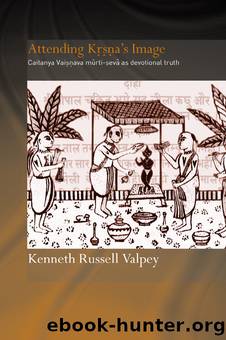Attending Krishna's Image by Valpey Kenneth Russell

Author:Valpey, Kenneth Russell
Language: eng
Format: epub
ISBN: 978-1-134-17545-1
Publisher: Taylor & Francis (CAM)
Ká¹á¹£á¹a in mleccha-deÅa
âKá¹á¹£á¹a is all-attractiveâ: a devotional empire expands
A brief account of Ká¹á¹£á¹aâs Western migration (and replication) through the establishment and spread of ISKCON (PrabhupÄdaâs acronym for the International Society for Krishna Consciousness) is now in order. ISKCONâs early history has been documented fairly extensively, but its temple worship â both in its conceptualization and its practice â has been treated only tangentially to other concerns.7
The early phase of ISKCONâs history was dominated by the charismatic presence of PrabhupÄda as a personable yet bold preacher of Ká¹á¹£á¹a-bhakti.8 In his presence, life for his followers was marked by novelty, simplicity and a measure of spontaneity. It was a time of heady expansion as the number of young followers multiplied rapidly. PrabhupÄdaâs every word and deed were seen by his followers as enactments of victorious conquest; indeed, followers regarded him as a general leading his troops to destroy the âspell of mÄyÄâ with the devotional practices of âKrishna consciousness,â especially the chanting of harinÄma. Doubtless PrabhupÄda was a charismatic figure for his followers, regarded as being âat the boundary of the human and the superhuman dimensions of existenceâ (Ketola 2002: 181), but those young people who joined his mission in the mid-1960s to mid-1970s in America and Europe saw him especially as an approachable embodiment of sacred tradition.9 His ability to impute Ká¹á¹£á¹a-centered living as an all-encompassing worldview to his followers was, he claimed, arising from his faithfulness to the teachings of his own guru. These teachings, in turn, were drawn from the texts PrabhupÄda had translated â texts that had been compiled, preserved, and handed down through disciplic succession. In short, following Max Weberâs typology, PrabhupÄda was to a large extent an institutional charismatic figure.10 As he said repeatedly of himself, he was a mere representative of his own guru and hence, by the principle of disciplic succession, a ârepresentative of Ká¹á¹£á¹a.â11 In that sense, his qualification was to be seen as attainable by others. As he said of himself, âYes, ⦠I strictly follow the instruction of my guru-mahÄrÄja, thatâs all. Otherwise I have no strength. I have not played any magicâ (750203mw.haw).
And so, from the beginning, PrabhupÄda intended to share his charisma. Ká¹á¹£á¹a, as the all-attractive âSupreme Personality of Godheadâ should be the central object of attention and devotion, and PrabhupÄda should be seen by his followers as Ká¹á¹£á¹aâs confidential servant. Moreover, Ká¹á¹£á¹a was to be the center of attention and devotion for communities of devotees, not merely for loose collections of individual spiritual seekers.
As we have seen, while still in India PrabhupÄda viewed temple establishment as integral to his mission. Soon after arriving in America he sought means to acquire a property convertable for use as a Ká¹á¹£á¹a temple, even before any of his sympathizers could be called serious followers, not to mention dedicated disciples or temple priests. Even as âNew JagannÄtha PurÄ«,â a rented storefront amid hippiedomâs Haight-Ashbury district of San Francisco, became the first ISKCON âtempleâ in early 1967 (as the hippie movement came to its
Download
This site does not store any files on its server. We only index and link to content provided by other sites. Please contact the content providers to delete copyright contents if any and email us, we'll remove relevant links or contents immediately.
The Lost Art of Listening by Michael P. Nichols(7353)
Why I Am Not A Calvinist by Dr. Peter S. Ruckman(4070)
The Rosicrucians by Christopher McIntosh(3436)
Wicca: a guide for the solitary practitioner by Scott Cunningham(3097)
Signature in the Cell: DNA and the Evidence for Intelligent Design by Stephen C. Meyer(2990)
Real Sex by Lauren F. Winner(2930)
The Holy Spirit by Billy Graham(2832)
To Light a Sacred Flame by Silver RavenWolf(2734)
The End of Faith by Sam Harris(2655)
The Gnostic Gospels by Pagels Elaine(2433)
Waking Up by Sam Harris(2353)
Nine Parts of Desire by Geraldine Brooks(2298)
Jesus by Paul Johnson(2266)
Devil, The by Almond Philip C(2237)
The God delusion by Richard Dawkins(2215)
Heavens on Earth by Michael Shermer(2209)
Kundalini by Gopi Krishna(2113)
Chosen by God by R. C. Sproul(2090)
The Nature of Consciousness by Rupert Spira(2005)
